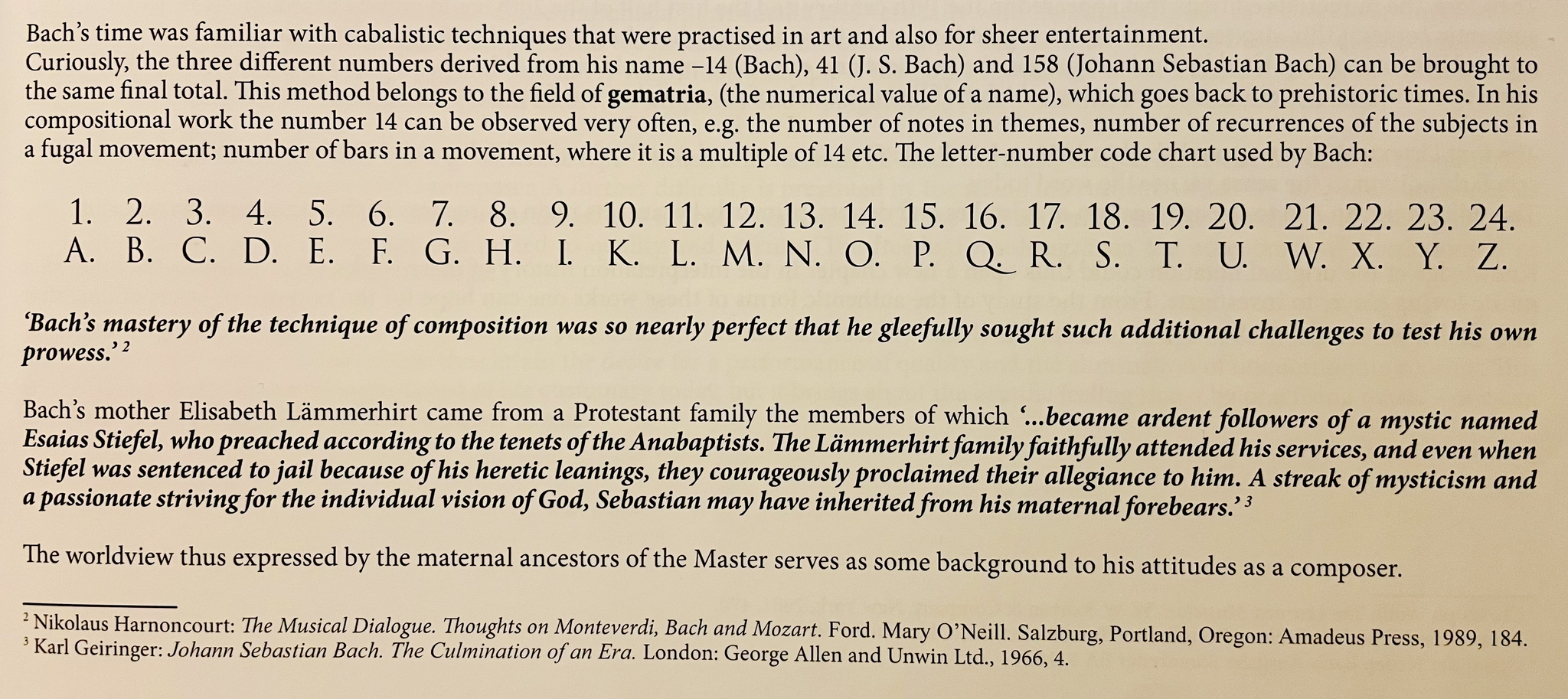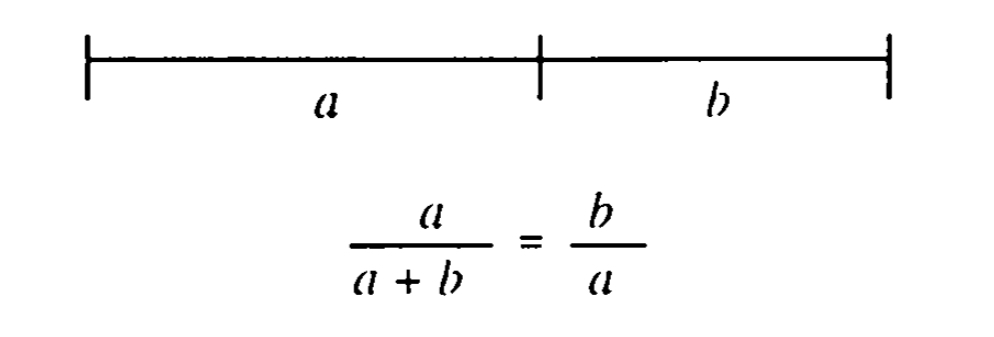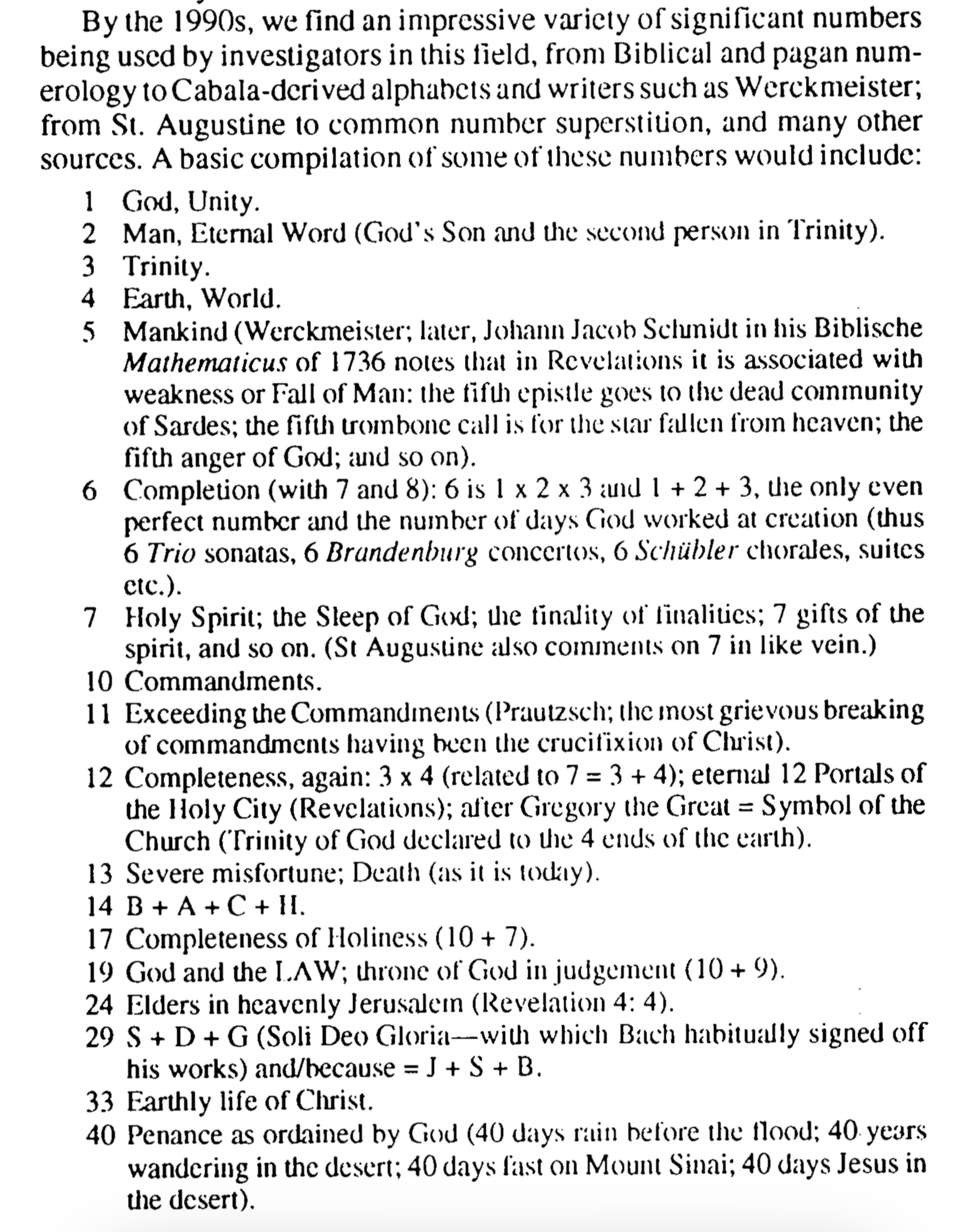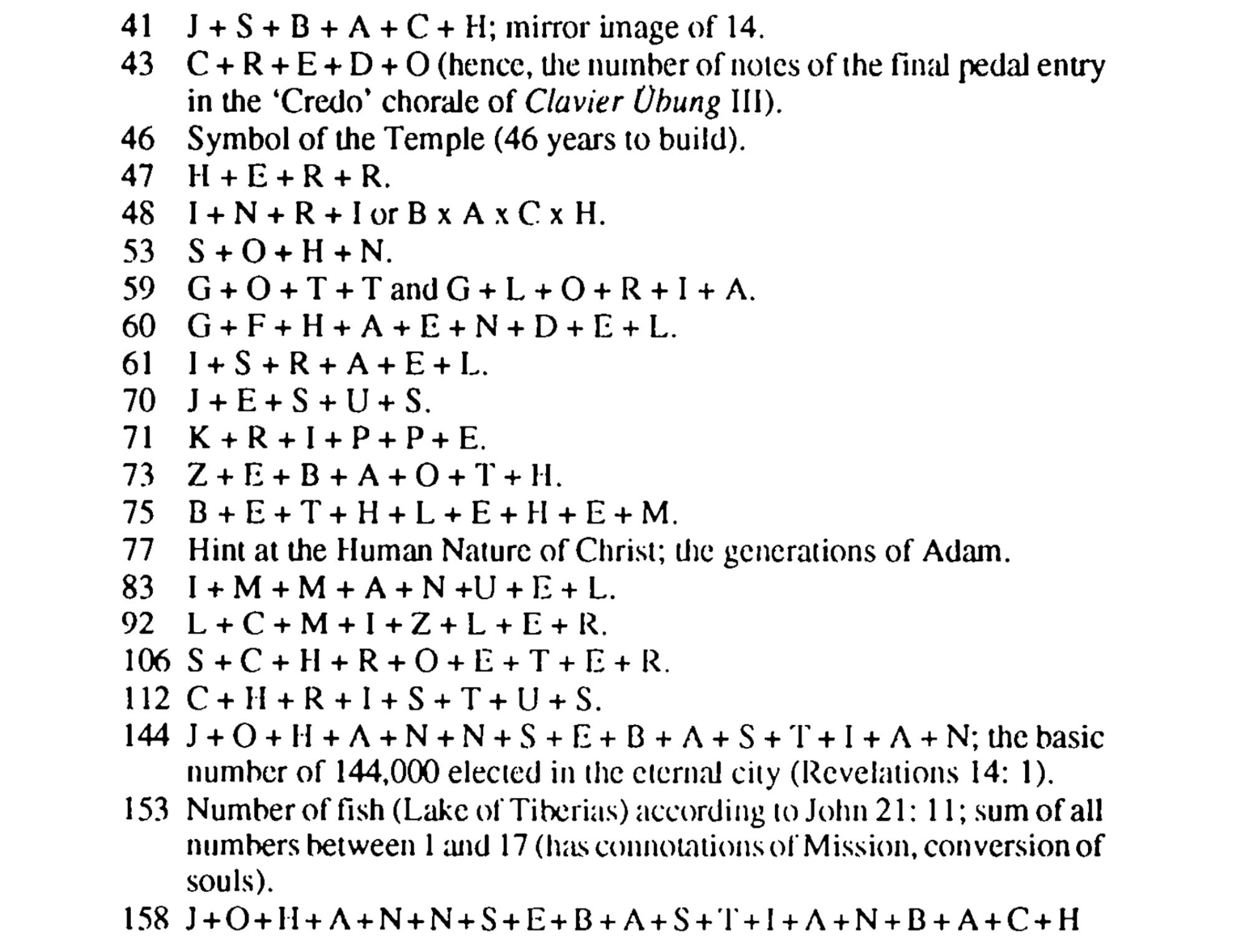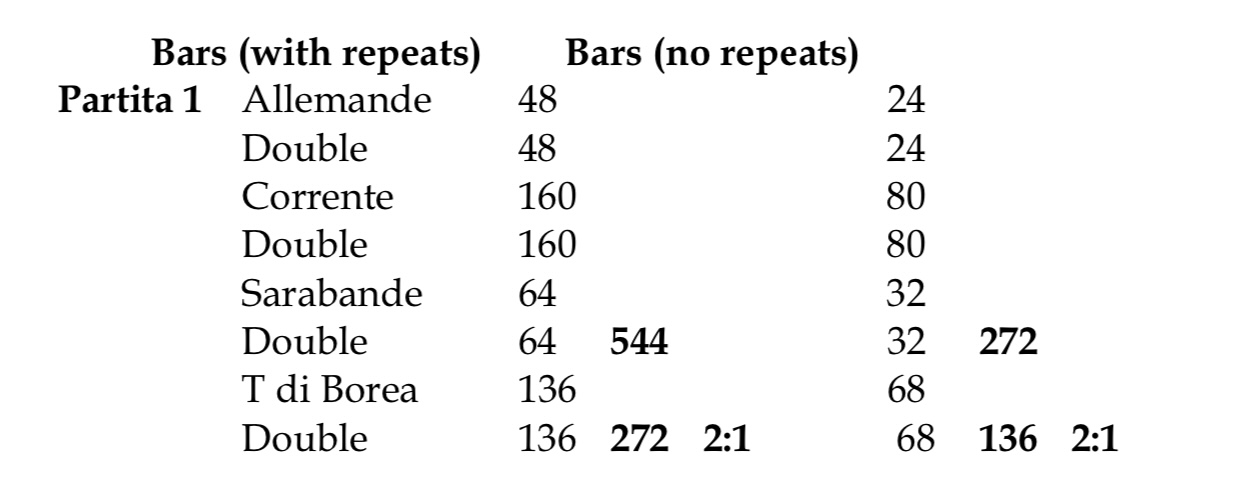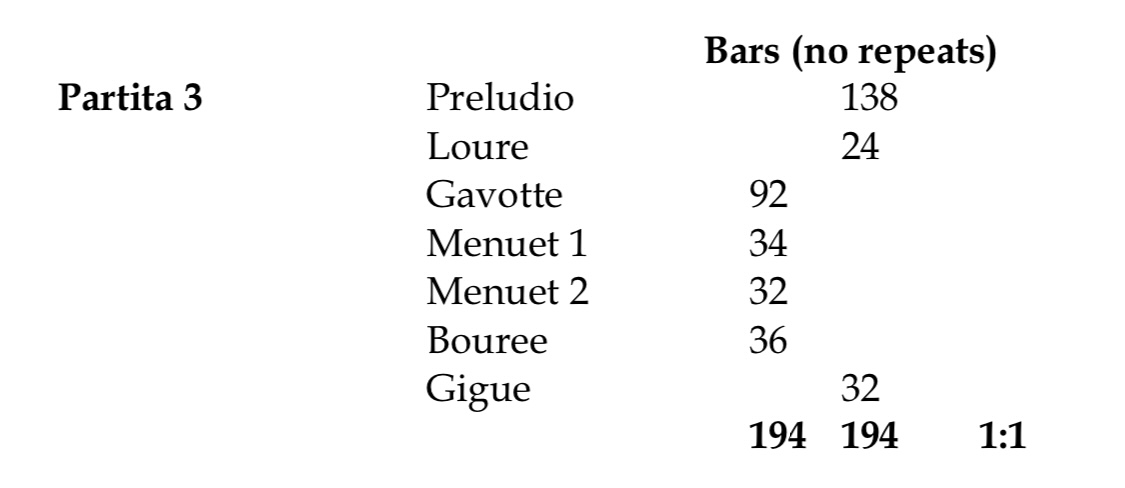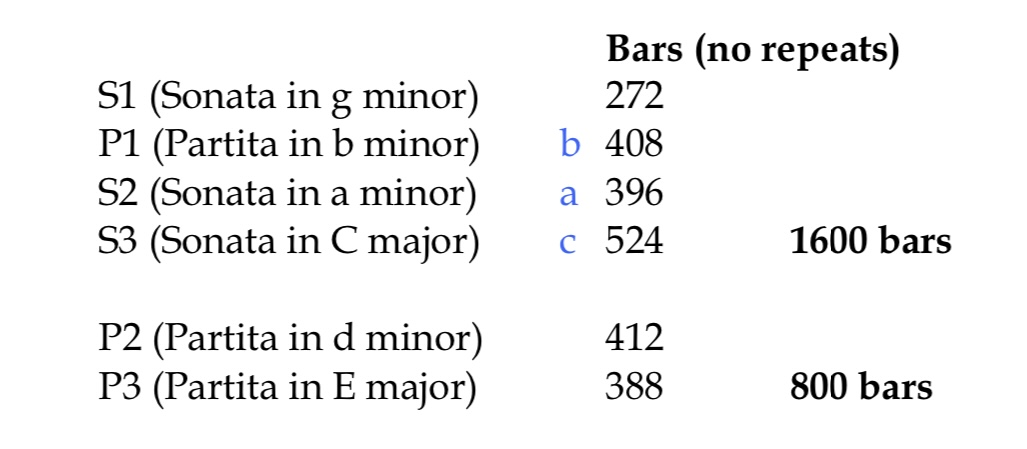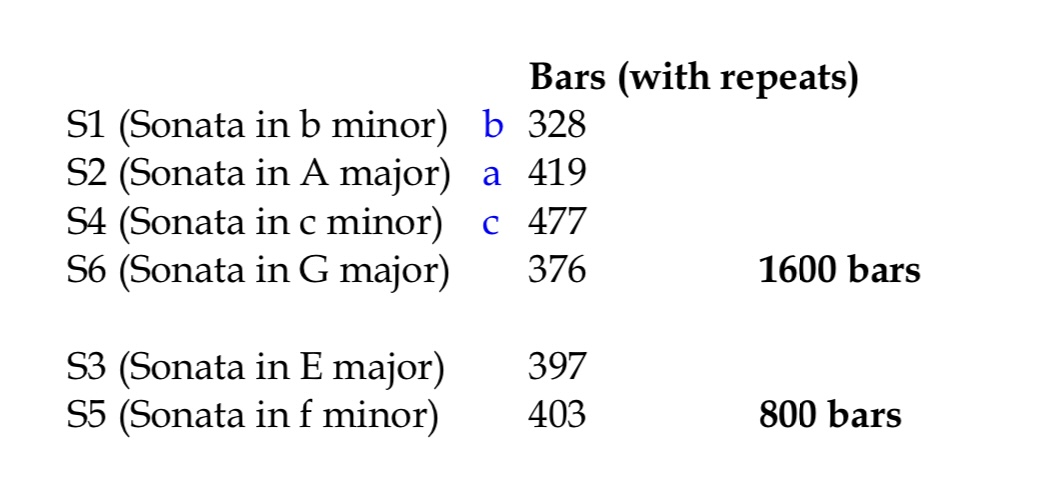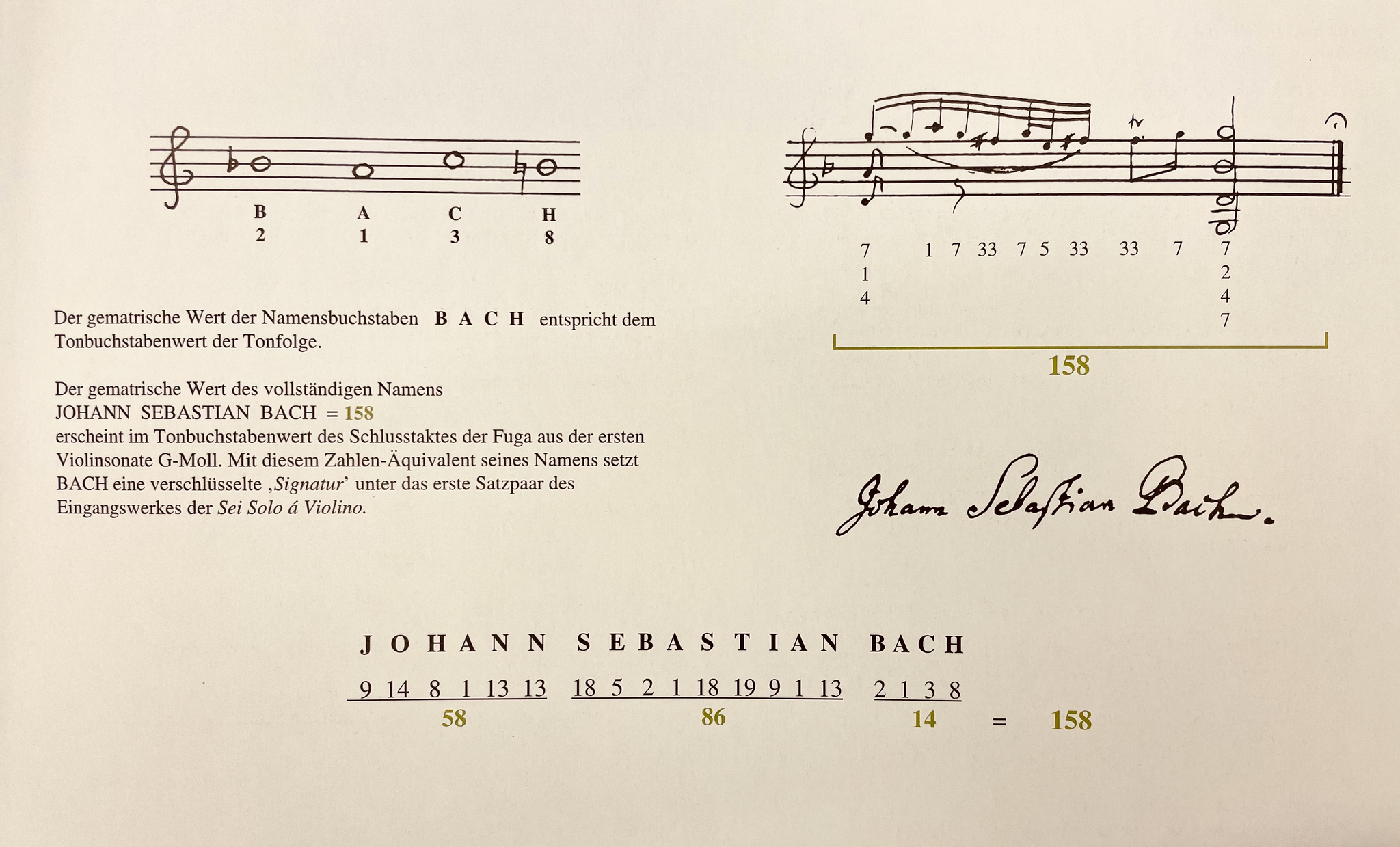back to Table of contents
The word "gematria," dating from c. A.D. 200, refers to the practice of "assigning numerical values to the letters of the alphabet.” Bach was a master of permutation.
“As a practicing Lutheran musician in Saxony during the eighteenth century, Johann Sebastian Bach encountered mathematics in one form or another in his daily life.” David Rumsey says in his book, Bach and Numerology 'dry mathematical stuff’?.
"There were other mathematical disciplines and pastimes current in Bach's day that had reached a climax chronologically and geographically precisely during his lifetime and in his region. Such publications as the Buch der Biblische Mathematicus of Johann Jakob Schmidt (1736), the preface to Pachelbel's Hexachordum Apollinis (1699), and Jakob Adlung's Anleitung zur musikalischen Gelahrtheit (1758) are among many that deal explicitly with number symbolism in the general cultural context of their day. Chapter 19 of the Paradoxal-Discourse of Andreas Werckmeister (1707) is entitled ‘Von der Zahlen geheimen Deutung' ('Of the secret meaning of numbers') and gives a basic listing of number-symbols. Werckmeister, who in a treatise on organ building nine years earlier had already established his credentials in other areas of mathematics, science and music, wrote thus:
As now the musical intervals are nothing other than numbers and proportions and since God created and ordered everything in Numbers, Proportion and Weighting, so also must the musician, indeed every person, be diligent and study how to reproduce such marvellous Order.
From these writings, we extract several important facts: first, that there were divisions of Mathematics which in those days were all respected as separate categories of the same discipline; second, that 'Biblical Mathematics' was one of these categories; third, that 'proportion' was another; fourth, that there was an established fascination with number systems and with the Cabala, particularly the use of gematria or number-substitute alphabets.”
Rumsey continues further: "We might dismiss these findings with scepticism. Yet they occur frequently and consistently and, if we take the trouble to understand the culture of Bach's era from his own perspective, it then becomes difficult simply to attribute them to mere coincidence. There is not much proof to confirm or deny that these number manipulations were taking place intentionally, but proof does exist. For instance, there are some fascinating numbers on the manuscript copy of 'Vor deinen Thron tret ich hiermit' in Bach's own handwriting. On one line, in a range of 1-10, the numbers 1-7 are underlined, while on the next, in a range of 1-5, the numbers 1-3 are underlined. Although their meaning remains obscure, the fact that they are significant numbers and that they seem to have had something to do with Bach's compositional processes would be hard to deny."1
Composer Barnabás Dukay and violinist Márta Ábrahám, both professors at the Liszt Ferenc Music Academy, provide the most detailed analysis of Bach’s most famous violin work, the Chaconne, in their book: Excerpts from Eternity.
They demonstrate the method of gematria and suggest that Bach may have encountered it through his mother.2
The number 144, in the Fibonacci sequence, also coincidentally matches the sum of the letters in J-O-H-A-N-N-E-S-E-B-A-S-T-I-A-N.3
Ramsey mentions that "If we take the great Leipzig C-minor Prelude (BWV 546) we note that it has two themes and that together these account for some 144 bars exactly. Not only is this a symbolic number itself (12 x 12), but the total bar numbers of two themes of 89 and 55 respectively form the final two stages of a standard Fibonacci series going from 1 through 144: 1 2 3 5 8 13 21 34 55 89 144. The further we progress along such a series the closer consecutive numbers come to the proportion of the 'Golden Section', the division of a given Iine so that the greater part is proportioned to the whole as the lesser part is to the greater:
The solution of the quadratic equation which results yields a ratio of approximately 1 : 0.618. The 'Golden Section' holds a special place in art and architecture, from the ancient Greeks to the present day, as a formula for perfection in proportions."4
I would also like to cite the list of number meanings in Ramsey's book.5
Ruth Tatlow conducted wonderful research on the numerical structure of Sei Solo, in her article Collections, bars and numbers: Analytical coincidence or Bach’s design?. The final result was the formulation of proportional parallelism.6
The Sei Solo demonstrate a remarkable series of proportions that exists concurrently at different construction levels, numbered below as levels 1-5. These are between:
Level 1 - sections of a movement (which I will ellaborate in the next chapter)
Level 2 - movements of a work (Table 1-3)
Level 3 - two works in a collection (Table 4)
Level 4 - collection as a whole (Table 5)
Level 5 - two collections(!!) (Table 7)
Below, I would like to cite Tatlow's study as it was very remarkable.
A clear 1:1 and 1:2 proportion can be seen in the bar structure of the first solo, the Sonata in G Minor (BWV 1001). On the written score, the first three movements (Adagio, Fuga and Siciliano) have 136 bars, while the fourth movement (Presto) has 136 bars, thus creating a 1:1 proportion (see Table 1).
In performance, due to repeats in the Presto the violinist plays 136 bars in the first three movements and 272 bars in the fourth, thus creating a 1:2 proportion.
Something very similar happens in the second solo, the Partita in B minor (BWV 1002). The partita has eight movements, formed by four movements and their respective doubles. On the written score the first six movements have 272 bars, while the final two movements have 136 bars, thus creating a 2:1 proportion (see Table 2). There are repeat indications in every movement, and so when these are observed the violinist still creates a 2:1 proportion, playing 544 bars in the first six movements and 272 bars in the fourth.
The sixth solo, the partita in E major, is the only other work in this collection to have a level 2 proportion. The Preludio, Loure and either Gigue or Menuet II have 194 bars, and the remaining four movements have 194 bars (see Table 3). This result on its own is not spectacular, and could easily be dismissed as arithmetical coincidence, but because this type of proportion, formed with few terms, is seen repeatedly across Bach’s works, it must be taken seriously. The proportion may also hold a clue to the compositional history of the collection.
Proportion Level 3: formed between two works in a collection
A 1:2 and 2:3 proportion is formed between the first and second works in the collection. When performed with all the repeats, the violinist plays 418 bars in the G Minor sonata and 816 bars in the B Minor partita. On the score a 2:3 proportion is formed by 272 and 408 bars (see Table 4).
Proportion Level 4: formed in the collection as a whole
The whole collection also forms a perfect 2:1 proportion. The Sei Solo cover 2400 written bars: four solos have exactly 1600 bars and the remaining two solos have 800 bars. The 2:1 proportion exists not only in the bar total 1600:800 but also in the number of works 4:2 (see Table 5).
The D Minor Ciaconna stands out in its Partita, not only due to its unusual placement after the final Giga but also because of its sheer length—257 bars compared to the combined 155 bars of the other four movements. A similar structural imbalance appears in the second and third sonatas, where massive fugues dominate. The A Minor Fuga spans 289 bars, more than twice the length of its surrounding movements (105 bars), while the C major Fuga extends to 354 bars, overshadowing the rest of the sonata (170 bars). These three monumental movements collectively total exactly 900 bars, making them strikingly prominent to both violinists and audiences. Intriguingly, these mammoth movements have exactly 900 bars (See Table 6).
Proportion Level 5: formed between two collections
There is one more level of proportion, which is perhaps the most bizarre of all the proportions present in Bach’s collections. The Sei Solo for violin has 1:1 proportion with the Six Sonatas for Violin and Harpsichord (BWV 1014-1019), which has exactly 2400 performed bars. The Six Sonatas also have a level four proportion identical to that in the Sei Solo: the level four 2:1 proportion in the Six sonatas is formed between the number of sonatas (4:2) as well as between the number of bars in the collection 1600:800 (see Table 7).
Many scholars have surmised that Bach intended there to be a Libro Secondo to his Libro Primo, the Sei Solo. It is usually thought that the Cello Suites (BWV 1007-1012) were designed to be that second collection. Interestingly, Anna Magdalena’s copy of the cello suites does not contain the numerical characteristics of a finally revised collection, nor does the numerical structure bear any resemblance to the Sei Solo. In view of this lack of structural resemblance, and in the light of the parallel structure with the Sei Solo, Tatlow proposes the Six Sonatas (BWV 1014-1019) rather than the Cello Suites that merit the title Libro Secondo.
In Helga Thoene's book, Johann Sebastian Bach. SONATA A-MOLL BWV 1003—Eine wortlose Passion: Analytische Studie, I was amazed to discover that the gematria sum of the last and penultimate bars of the Fuga in the Sonata in G Minor(BWV 1001) is 158, a number associated with Johann Sebastian Bach. While conclusive evidence cannot be obtained, but I would like to respect the passion and dedication of scholars in their examinations and discoveries.7
Now, let's move on to the next chapter, where I will ellaborate these ideas in my actuall research, exploring Allegory and Symbolisms in Sei Solo. For this case study, I have chosen Adagio, the first movement of the first Sonata in G Minor (BWV 1001) for an in-depth exploration. I intend to continue and expand my research further in the future.
_______________
1David Rumsey, Bach and Numerology 'dry mathematical stuff'? (LitAesth, Vol. 7, 1997), pp.146-9.
2Barnabás Dukay & Márta Ábrahám, Excerpts from Eternity (BioBach-Music Book and Music Publishing, 2017), p.17.
3Rumsey (n 1), p.154.
4ibid., pp.148-9.
5ibid., pp.153-4.
6Ruth Tatlow, Collections, bars and numbers: Analytical coincidence or Bach’s design? (Web Journal of Bach Network UK, 2007), pp.46-53.
7Helga Thoene, Johann Sebastian Bach. SONATA A-MOLL BWV1003ーEine wortlose Passion: Anaytische Studie (Berkeley: Ziethen, 2005), p.23.
Next: Chapter V. Analysation on Adagio from G minor Sonata BWV1001
back to Table of contents
